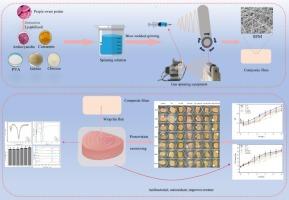Preparation of tuna skin gelatin–polyphenol intelligent packaging film and its application in the preservation of tuna
IF 9.8
1区 农林科学
Q1 CHEMISTRY, APPLIED
引用次数: 0
Abstract
To address aquatic product preservation challenges, this study developed an intelligent label leveraging natural pigments' antibacterial and responsive properties. A composite film integrating purple sweet potato anthocyanins and curcumin was fabricated via blow-spinning technology. The gelatin-polyvinyl alcohol-chitosan interpenetrating polymer network significantly enhanced film properties, including hydrophobicity (water contact angle: 102.8° ± 1.56°), thermal stability (Peak heat absorption:123 °C), and elongation at break (stress: 1.18 kg/mm2, stain: 43 %). The film delayed tuna spoilage through synergistic mechanisms: curcumin disrupted bacterial biofilm integrity (total bacterial count reduced by 3.37 log CFU/g), inhibited lipid oxidation, while the curcumin/anthocyanin composite film (GC-CR/ATH) reduced metmyoglobin content to 21.8 g/s and delayed browning. The PVA-incorporated GCP-CR/ATH film optimized sustained release of active compounds and maintained fish texture (springiness: 0.42 mm, hardness: 12.5 N) via “antibacterial-antioxidant-pH responsive” synergy. This work provides theoretical support for real-time freshness monitoring and active packaging in aquatic products.


金枪鱼皮明胶-多酚智能包装膜的制备及其在金枪鱼保鲜中的应用
为了解决水产品保存的挑战,本研究开发了一种利用天然色素的抗菌和反应特性的智能标签。采用吹风纺丝工艺制备了紫薯花青素和姜黄素的复合膜。明胶-聚乙烯醇-壳聚糖互穿聚合物网络显著提高了薄膜的性能,包括疏水性(水接触角:102.8° ± 1.56°)、热稳定性(峰值吸热:123 °C)和断裂伸长率(应力:1.18 kg/mm2,染率:43 %)。该膜通过协同机制延缓了金枪鱼的腐败:姜黄素破坏了细菌生物膜的完整性(细菌总数减少了3.37 log CFU/g),抑制了脂质氧化,而姜黄素/花青素复合膜(GC-CR/ATH)将肌红蛋白含量降低到21.8 g/s,延缓了褐变。pva掺入的GCP-CR/ATH膜通过“抗菌-抗氧化- ph响应”协同作用,优化了活性化合物的缓释,并保持了鱼的质地(弹性:0.42 mm,硬度:12.5 N)。本研究为水产品实时新鲜度监测和活性包装提供了理论支持。
本文章由计算机程序翻译,如有差异,请以英文原文为准。
求助全文
约1分钟内获得全文
求助全文
来源期刊

Food Chemistry
工程技术-食品科技
CiteScore
16.30
自引率
10.20%
发文量
3130
审稿时长
122 days
期刊介绍:
Food Chemistry publishes original research papers dealing with the advancement of the chemistry and biochemistry of foods or the analytical methods/ approach used. All papers should focus on the novelty of the research carried out.
 求助内容:
求助内容: 应助结果提醒方式:
应助结果提醒方式:


